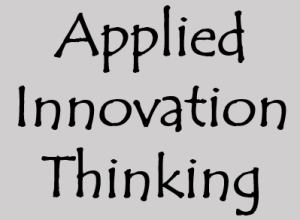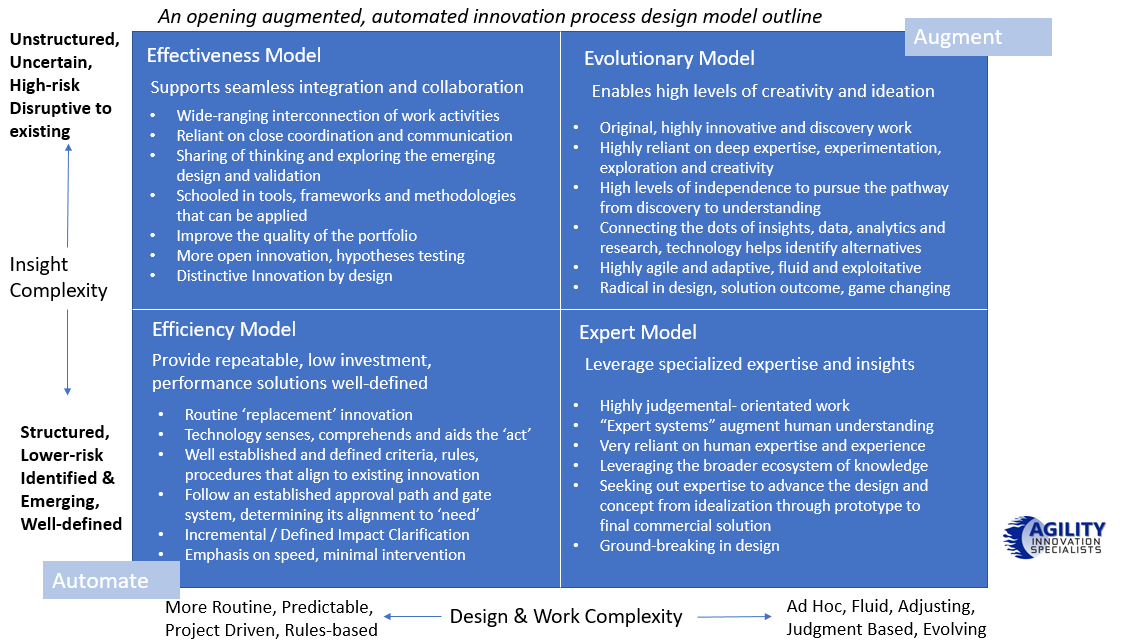 I wrote a post “Needing to Think Applied Innovation Services” recently, it was extending my view that innovation needs to change. We need to think of managing innovation in different ways, we need to automate it and in addition, augment it. I suggested in that post “we need to pull down what is needed” and design a totally ‘adaptive’ innovation process to fit a specific need.
I wrote a post “Needing to Think Applied Innovation Services” recently, it was extending my view that innovation needs to change. We need to think of managing innovation in different ways, we need to automate it and in addition, augment it. I suggested in that post “we need to pull down what is needed” and design a totally ‘adaptive’ innovation process to fit a specific need.
I argued we need to think differently about how we manage innovation. It needs to be more radical in design, actually, it needs to be far more up to date and in tune with the technology progress we recommend so much to others! Innovation systems are lagging, they should be leading in their design and connectivity.
What I mean by this is it needs to begin to ‘account’ for cognitive solutions that can augment and help automate our present highly manual innovation systems. I know we have some good software for different parts of the innovation process but none of these are integrated, fully connected up in their design. We still work in piecing them together. We lose significant collaborative opportunities and speed due to this mostly disjointed innovation approach. Surely this has to change?
We need to bring innovation and its process up to date. With cognitive computing, artificial intelligence, cloud-based solutions, purposefully designed apps and specific tools and frameworks, we do need to begin to stretch our imaginations further and flex our technology and app solutions more towards providing a better, more connected innovation process. I want to see a new innovation era happen.
I’ve pushed the idea of highly adaptive applications that are selected to do the job on hand. We all recognize “one size does not fit all” and that is absolutely clear when we have incremental, distinctive, radical and ground-breaking innovation all trying to be squeezed through the same innovation process design. This squeezing does exactly that, it squeezes the life out of the creative process, measuring all that goes through an innovation pipeline with the same measuring stick, it takes away trust, judgment, and inventiveness and replaces this with ‘watered down’ solutions that emerge out into the real-life world. They have been risk-reduced and judged on their return on investment, even if they are unknown to the world. The hard dominates the soft, the rational need over the emotive need.
We need to change this but it needs a concerted effort to think differently. I have scouted around in ways to advance my own thinking and I came across an article by Accenture Turning Cognitive Computing into Business Value Today and it had one visual that held my attention. So I’ve reworked it for where I think it can go for innovation. It gave me a break-through moment in how I could see innovation processes can advance in combining the human and automating design as it frames innovation to allow differences to be designed in, determined by the ‘type of innovation’ we want to achieve.
An augmented, automated innovation process design model that might advance on today’s not fit for purpose innovation process
Here is what I came up with. It is a prototype version one. It break down innovation into different types of innovation impact, into four distinct parts, and then attempts to decide what needs to go into these. It certainly as an emerging model is needed to be pushed, questioned and validated but let me ‘release it’ to the world as a work-in-progress, publish and be dammed.
So I’m not going to explain the parts here, I will do this in a further post as I did not wish to extend the post here unnecessarily. It needs more technology ‘layering-in’ to the specific parts.
What I ask and lifted out one nice visual from that Accenture report that asks this of you:
 Innovation and how we manage the process and its “static” design needs radically changing. It needs to be far more connected (up) and automated, dynamic in its design and parts, adaptive to the specific need or challenge. We are in the age where technology can make this possible, can we make it realizable? Can we advance how we manage innovation in its process, in its discipline and design, that gives ‘us’ the potential for greater growth and advancement?
Innovation and how we manage the process and its “static” design needs radically changing. It needs to be far more connected (up) and automated, dynamic in its design and parts, adaptive to the specific need or challenge. We are in the age where technology can make this possible, can we make it realizable? Can we advance how we manage innovation in its process, in its discipline and design, that gives ‘us’ the potential for greater growth and advancement?
What do you think of this suggested model shown above, part of the innovation puzzle we need to design? Can you see its design and its parts that will require different alignment between the human managing the innovation idea and the power of different technologies to automate and augment it in better ways than we are having as solutions today?

3 thoughts on “Advancing My Applied Innovation Thinking”
Comments are closed.